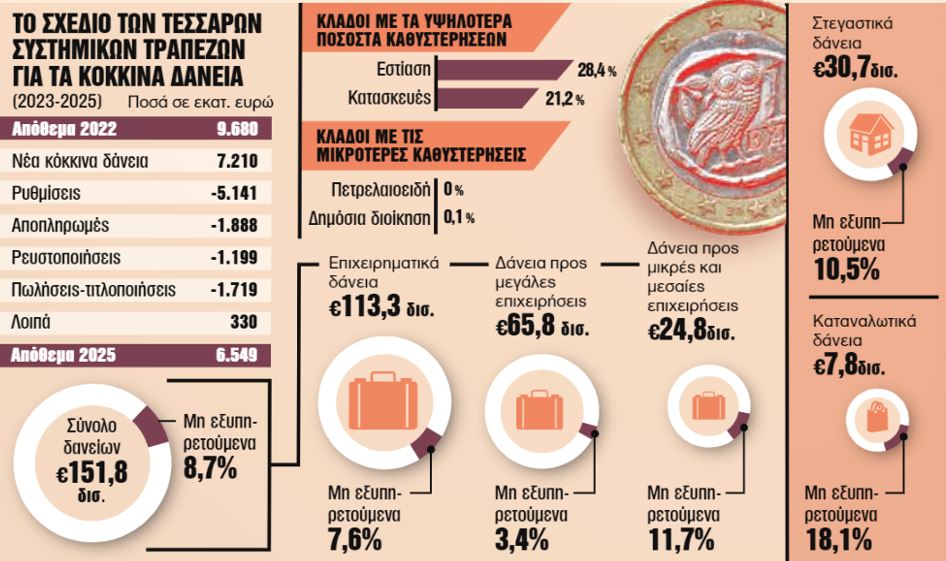
The banks expect to generate new red funds of more than €7 billion which they will deal with primarily through write-offs and adjustments and secondarily through sales of funds.
Business loans are the ones that have been blushing in relation to the rest of the bank loans, and the restaurant segment holds the acceptance of non-performing loans in the business portfolio, followed by construction and trade. This is mainly due to the high percentage of non-performing loans of small, medium and very small enterprises.
Although the overall picture shows a decrease in non-performing loans in recent years, delinquencies in 2022 from 1 day to 90 days increased by 22.6% (to 4.9 billion euros) and mainly come from business loans. Loans overdue for more than 90 days decreased to €4.4 billion (-23.1%), of which 77% of bad loans with these characteristics were overdue for more than a year (up 69.8% from 2021). The corresponding default rate for commercial loans was 84.4%, for housing loans 58.7%, and for consumer loans 68.2%. The delinquency rate for commercial loans over time was 84.4%, for housing loans 58.7%, and for consumer loans 68.2%.
An important component, which partly explains the relatively higher percentage of non-performing loans in firms, is the higher level of borrowing. In December 2022, according to Bank of Greece data, corporate financing, with items on the balance sheet, amounted to 113.3 billion euros, which represents about 75% of the total financing of the economy by Greek credit institutions. The percentage of bad loans in the business portfolio was 7.6%, mainly due to the high percentage of non-performing loans for small and medium enterprises (11.7%) and very small enterprises (27.1%).
Loan write-off
Credit institutions’ plans to further reduce non-performing loans by 32% by 2025 reveal that banks expect more than €7 billion in new non-performing loans. However, they will be able to reduce the total non-performing loan inventory with more write-offs, i.e. haircuts, and less with auctions. The fine lines of the reduction plans show that it will be primarily through loan repayments (€1.9 billion) and write-downs (€1.7 billion) and secondarily via sales (€0.7 billion) and collateral liquidation (€0.5 billion). It should be noted that loans written off in 2022 amounted to 1 billion euros, of which 0.6 billion euros related to canceled claims, mainly business loans (0.5 billion euros). However, the net inflow is expected to remain positive at 2.1 billion euros, due, according to the Bank of Greece report, to the current economic conditions that are expected to put pressure on the financial situation of households and companies in the short term.
In this climate, the banking system is on alert to avoid a new generation of bad loans, and the shield is to reduce non-performing loans to 6.549 billion euros at the end of 2025, from 9.68 billion euros in 2022. With this reduction, the proportion of non-performing loans will decrease from 7% to 4%, which is a step closer to the European average. It should be noted that the ratio of non-performing loans in total loans (December 2022: 8.7%) decreased, but is still much higher than the corresponding European average.
X-rays in red
Regarding the structure of financing in the sectors of the Greek economy, the greatest concentration concerns financial companies (24% of total corporate financing, against 26% for 2021). This segment includes the high priority repayment securitization divisions held by institutions under the Heracles programme. The non-performing loan ratio for this sector is much lower than the average ratio for the corresponding commercial loans (0.8% in 2022, compared to 3.1% for 2021). The highest percentages were recorded in the restaurant sector (28.4%), construction (21.2%), trade (13.3%), real estate management (12%), accommodation (10.5%), agricultural activities (10.3%) and manufacturing (10%). %). High percentages are also recorded in individual branches of manufacturing, such as the textile industry (30.3%), the paper, wood and furniture industry (21.7%) and other manufacturing activities (20.6%), which however relate to smaller loan balances and thus have little impact on the formation of the total non-performing loans index for the sector manufacturing. The lowest percentages were indicative in the energy sectors (1%) and financial companies (0.8%).

“Avid problem solver. Extreme social media junkie. Beer buff. Coffee guru. Internet geek. Travel ninja.”





More Stories
Retrospective for retirees: Who is affected, who wins and who loses – Newsbomb – News
With…Rural Sakis Rouvas
The data-altering 'treasure' is coming – where is it?